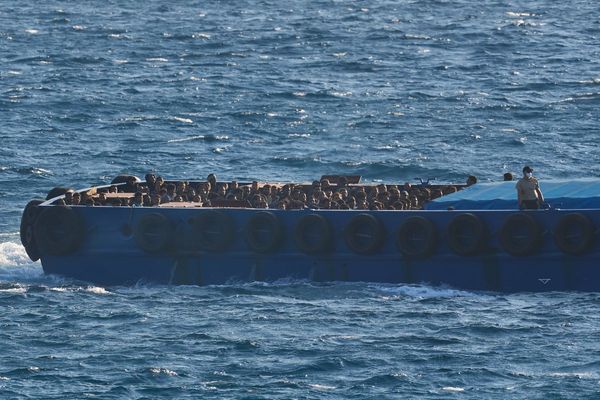
People rave about La Pelosa beach in Sardinia’s north-west: it has “stunning white sand”, “clear turquoise water”, “breathtaking beauty” and is one of Lonely Planet’s best beaches in Italy. But please don’t go there. Even a decade ago when I was first checking out Sardinia’s glorious coast, crowds and costly parking at La Pelosa put me off. Now a private beach, it is a sad victim of its own success and a million social media posts. Would-be beachgoers hunch over their phones at 8am when online sales open, hoping to bag a ticket (€3.50pp, parking extra, 1,500 available).
They have to arrive armed with straw mats or microfibre towels: until terry towels were banned in 2019, each sunseeker would carry away up to 100g of that white sand, and the beach was visibly shrinking, leaving even less room for sunbathers to fight over. (The shallow, warm water attracts young families, but parents report attendants banning sandcastles because digging damages the now-fragile beach.)
What’s truly stunning about all this is that north-west Sardinia has dozens of lovely beaches, most of them not only free but relatively crowd-free. Close to Alghero, the beaches of Lazzaretto and Le Bombarde offer soft sand, a bar and a small sunbed concession, and are accessible by bus, cycle track or (longish) walk from welcoming Hotel Punta Negra (doubles from €130), which has a big pool and its own small beach.
Wilder Porto Ferro, about 10 miles north, has well over a mile of west-facing amber sands perfect for a sunset swim and picnic. And even the Stintino peninsula, with La Pelosa at its tip, has a wealth of preferable bathing spots – Le Saline on the east side, say, for acres of white sand, or Coscia di Donna (lady’s thigh), a cute rocky cove on the west.
Stintino town is pleasantly unpretentious, but the main reason to go is to leave it again – on a boat to coastal Sardinia’s wildest destination, the mountainous “donkey” island of Asinara, 10 miles long and just a few hundred metres wide in parts. A prison island until 1997, it is now a national park and marine reserve, with one permanent inhabitant – guard turned sculptor Enrico Mereu.
With one ferry a day from Stintino and three from Porto Torres further south, there is little chance of Asinara feeling busy, and though there are many rules (no private cars, no dogs, no anchoring, no smoking except at the cafe), they’re there to preserve its wild beauty. A bay on the island’s east coast is off limits even to walkers, on pain of a fine. But this means we get to enjoy – from the main track – the rare sight of a beach as it might have looked a thousand years ago, with no people and untrampled vegetation growing to the sand’s edge.
Hiking on Asinara’s miles of footpaths is popular, but to see it in a day it’s worth cycling (on your own wheels or a hired ebike) or taking a tour in a hybrid 4x4. For this we team up with locally born nature lover Fabio Mara, who moved back eight years ago to start tour operator Sardinsula, offering sustainable, active, “slow” breaks in north-west Sardinia.
The island may have only one human inhabitant, but it has hundreds of others, with four legs and two. Spring-fed Lago di Fornelli, near the port, is like an African watering hole, attracting spindly-legged wild horses, grey donkeys with punky manes and all kinds of birds – red-legged stilts, egrets, herons. We are excited to also see a flurry of stripy wild boar piglets, but Fabio tells us they’re a problem, fond of snacking on the eggs of ground-nesting birds.
Driving north, he points out a family of Asinara’s emblematic albino donkeys, the mum showing a foal how to rub its head in dust to keep the sun off (lacking melanin, they are prone to skin cancers). Further on, the turtle rescue centre (open 15 May-30 Sept) has displays about the harm fishing and other human activities do to loggerheads. In tanks downstairs, convalescents Emma and Silvestro wait stoically for release back into the sea.
Between 1885 and 1997, animals shared this beautiful island with various unhappy and/or undesirable humans. It was a leper colony in the 19th century, a PoW camp in both world wars, and in the 1970s had a high-security jail that held mafia bosses, kidnappers and drug barons. (Strong currents mean it is virtually impossible to escape from Asinara.) A dozen former prison buildings dot the terrain – some now ruined, their shade enjoyed by goats and donkeys.
Less-dangerous prisoners worked on the land and their former quarters in the “agricultural colony” can be visited. It’s an attractive building with a vast courtyard – it would make a fine boutique hotel – but displays inside of tools, possessions and scary medical instruments tell a different story: crowded dormitories, sudden violence and hard labour in the cruel sun.
Relishing our happier lot, we buy cold drinks and filled focaccia at the nearby Sognasinara cooperative (which has hostel beds, from €45, in the former warders’ barracks) and head for the beach. Cala Sabina looks idyllic but there are, gosh, three or four people there. We walk five minutes more and find a sandy horseshoe cove, Cala Giordano, all to ourselves. It even has a shaded table and benches for our picnic. I resist posting pictures of its oh so Instagrammable vivid blue and turquoise waters.
To be handy for the 9.30am ferry, we stayed in a B&B on the “mainland”. Villa Li Curiazzi (doubles from €190) is a gorgeous spot that happens to be walking distance from La Pelosa – though who’d bother when the five-room villa has its own little white beach, with picturesquely weathered jetty? It is also admirably green, serving breakfasts of zero-km fruit, cheese, honey and olives on the beach terrace, and encouraging recycling into five wicker baskets in a corner of the sea-view breakfast/living room.
This peninsula is lovely, but it is firmly on the tourist map. South-east across the Asinara gulf, however, lies a coastal area that actively wants more tourists, not fewer. Amid vines, olives and fruit trees in a natural amphitheatre of hills above the sea, the 1,000-year-old town of Sennori is known for its elaborate traditional costumes – on parade at feasts including Sant’Efisio in May – the summer-long Cavart environment festival and music events in a panoramic former quarry at the top of town.
It’s also a good place to dip into more ancient Sardinia. Five centuries before the Romans, Nuragic culture flourished on the island, and though no written records have been discovered, they left mysterious cone-shaped towers (the Palmavera complex near Alghero is worth visiting), standing stones and burial chambers – rough contemporaries of Stonehenge.
Many of these sites are in remote spots and visited only by history buffs, but Sennori has a domus de janas – the dialect word for rock-cut tomb, it means “fairy house” – in the former priest’s garden near the 14th-century church. We ring a number on the locked gate and a smiling woman from a nearby bar comes to open up. Higher up, behind a pomegranate tree, we crawl into the first of about 10 linked chambers, noting the bull reliefs carved on a dividing wall and think of human lives lived here 7,000 years ago, and bodies returned to the embrace of Mother Earth.
Sardinia has applied for Unesco listing for 35 Nuragic sites, including this one. Success would put Sennori on the map, but there is so little tourist accommodation here that old houses are being offered for €1 to anyone who will live there and run it as a B&B.
For now the place to stay is Hotel Bajaloglia, from a pricey €210, but with great views of Castelsardo, a fairytale walled town once accessible only by sea, with castle, cathedral and a long basketweaving tradition. Beaches to east and west include Lu Bagnu, reached down steps from the village, with creamy sand and clear waters especially good for snorkelling. The Bajaloglia’s rooms and pool are dotted over a rocky outcrop and its restaurant serves probably the best pasta I’ve ever eaten – tagliolini cacio e pepe with lime and slivers of squid.
After leaving Sennori we drive 10 minutes to the beach. Marina di Sorso isn’t as postcard-pretty as La Pelosa, but it is quiet and dune-backed, on a curve of pale gold sand stretching miles in both directions. After a dip we relax with a beer, glad no one could ever sell tickets for seaside on this scale.
A full-day tour of Asinara for two with Sardinsula, including guide, ferry crossings and hybrid Jeep, costs €260. The company also offers two- to five-day active breaks across north-west Sardinia. Accommodation was provided by Villa li Curiazzi, Hotel Punta Negra and Bajaloglia Resort







